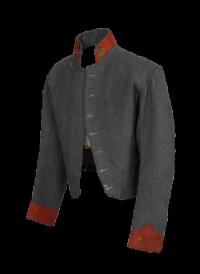Tait uniforms
Sir Peter Tait was born in Scotland in 1828 but moved to Limerick at a young age
His most lucrative client was the British Army, particularly during the Crimean War. He produced some 120,000 British uniforms between 1856 and 1858. By then he had moved to larger premises on Edward Street, employing 1,300 staff.Peter Tait’s and Limerick’s connection with the American Civil War began in December 1863, when 50,000 caps, greatcoats, jackets, trousers, shirts, blankets, boots, stockings and haversacks were ordered by the Confederate government. Tait also entered into a separate contract with the state of Alabama in June 1864. In order to fulfil his contracts Tait had to navigate one rather tricky obstacle—the federal blockade of Southern ports. He employed ships such as the Evelyn, which managed to run the blockade five times, with her last departure from Foynes, Co. Limerick, in October 1864; she would not return until September 1865. Another was the Condor, which ran aground off Fort Fisher in North Carolina in late 1864. Though her cargo was safely loaded onto another ship and brought ashore, the famous Confederate agent Rose O’Neal Greenhow, who had been returning from Europe, was drowned.A number of Tait Confederate jackets survive, mainly ones issued late in the war. The surviving examples are of cadet grey kersey with linen lining, and are further identifiable through their eight-button front, with five-piece bodies, two-piece sleeves and wool broadcloth collars. Tait of Limerick buttons—marked ‘P. Tait & Co./Limerick’ on the back—are also regularly recovered by relic-hunters on Civil War battle sites. The most common survivals of both jackets and buttons are in north-east Carolina, and the Petersburg and Appomattox campaigns. Peter Tait continued to prosper despite the defeat of the Confederacy, and he became mayor of Limerick between 1866 and 1868.
http://www.historyireland.com/18th-19th-century-history/tait-uniforms/
New book reveals strong Limerick connection to American Civil War
Such was the renown of the factory that it was a featured in a London Times article of the time, which remarked on its modern working conditions and the efficiency with which it was capable of producing garments.
This efficiency was put to good use when the firm won a contract to supply the Confederate government with some 50,000 uniforms in 1863 - at the height of the American civil war.
In the book, the authors reproduce various documents relating to this - and other - contracts with the Confederate government, including a letter written in December 1863 by Peter Tait’s brother - and agent - James to the Confederate Secretary of War, James A Seddon offering to supply his army with 50,000 uniforms, shirts and caps, 10,000 pairs of boots, 100,000 pairs of stockings and 50,000 haversacks to the total value of £158,475 sterling. A further contract to supply 40,000 uniforms was signed a year later in October 1864 - leading the authors to conclude that ‘Peter Tait and Co intended to become the largest supplier of uniforms to the Confederate States, and was poised to do so had to war gone on past April 1865.
However, in order for Tait to get these uniforms to the Confederate armies, he first had to defy the union blockade which aimed to prevent supplies reaching the Southern states. The Alabama state contract led to Tait buying a share in the steamship Evelyn - eventually owning a two-thirds share in the ship. It departed Limerick for Bermuda on October 27 of that year and from there to Wilmington, North Carolina where most of the uniforms were successfully unloaded.
http://www.limerickleader.ie/news/a...-book-reveals-strong-Limerick-connection.html